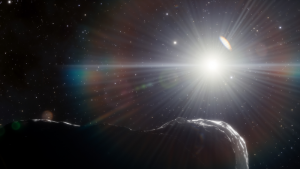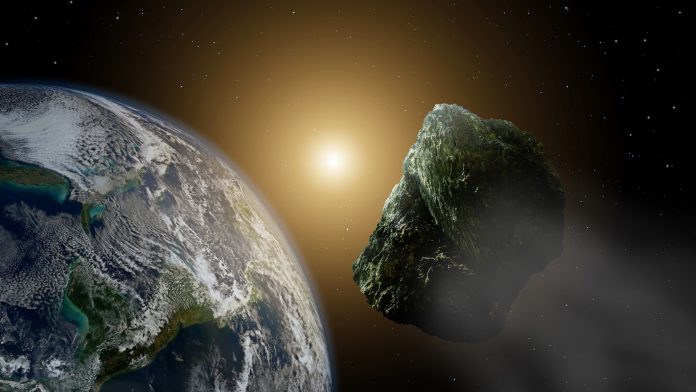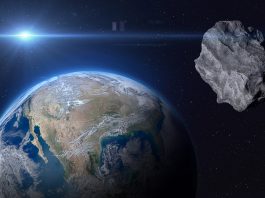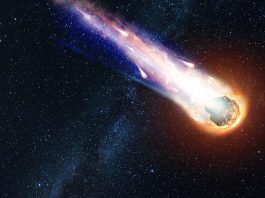Astronomers have detected three near-Earth asteroids, one of which is the largest, potentially hazardous object to be discovered in the last eight years.
An international team of astronomers have been able to observe three near-Earth asteroids hiding in the glare of the Sun by using twilight observations with the US Department of Energy-fabricated Dark Energy Camera at Cerro Tololo Inter-American Observatory in Chile, a programme of NSF’s NOIRLab. The near-Earth asteroids detected are part of an elusive group that can be found inside the orbits of Earth and Venus. The astronomers found that one of the asteroids is the largest, potentially hazardous object to be discovered in the last eight years.
The paper titled, ‘A Deep and Wide Twilight Survey for Asteroids Interior to Earth and Venus,’ was published in The Astronomical Journal.
The discovery and observation of the near-Earth asteroids
To detect the trio of asteroids, the astronomers took advantage of the brief yet favourable conditions during twilight. One is a 1.5-kilometre-wide asteroid called 2022 AP7, which has an orbit that may place it in Earth’s path. The other asteroids, called 2021 LJ4 and 2021 PH27, will remain completely interior to Earth’s orbit.
The astronomers also found that 2021 PH27 is the closest known asteroid to the Sun, meaning that it has the largest general-relativity effects of any object in our solar system. During its orbit, its surface also becomes hot enough to melt lead.
“Our twilight survey is scouring the area within the orbits of Earth and Venus for asteroids,” said Scott S Sheppard, an astronomer at the Earth and Planets Laboratory of the Carnegie Institution for Science and the lead author of the paper. “So far we have found two large near-Earth asteroids that are about one kilometre across, a size that we call planet killers.”
“There are likely only a few NEAs with similar sizes left to find, and these large undiscovered asteroids likely have orbits that keep them interior to the orbits of Earth and Venus most of the time,” said Sheppard. “Only about 25 asteroids with orbits completely within Earth’s orbit have been discovered to date because of the difficulty of observing near the glare of the Sun.”

What are the challenges associated with the detection of these asteroids?
Detecting asteroids in the inner solar system is very challenging due to the glare of the Sun. Because of this, astronomers only have two brief ten-minute windows each night to survey the area.
These observations are also near the horizon, which means that astronomers must examine through a thick layer of Earth’s atmosphere. This can distort and blur observations.
Overcoming these observational challenges with innovative technology
Despite these challenges, the three near-Earth asteroids were discovered due to the observing capabilities of DECam, one of the highest-performance, wide-field CCD imagers in the world. This technology allows astronomers to capture large areas of the sky with great sensitivity. Observations are referred to as ‘deep’ if faint objects are captured. When searching for asteroids inside Earth’s orbit, the capability to capture both deep and wide-field observations is essential.
Sheppard stated: “Large areas of the sky are required because the inner asteroids are rare, and deep images are needed because asteroids are faint, and you are fighting the bright twilight sky near the Sun as well as the distorting effect of Earth’s atmosphere.
“DECam can cover large areas of sky to depths not achievable on smaller telescopes, allowing us to go deeper, cover more sky, and probe the inner solar system in ways never done before.”
An important step toward the understanding of asteroids
Further to detecting potentially hazardous near-Earth asteroids, the research will progress our understanding of the distribution of small bodies in our solar system. Asteroids that are further from the Sun than Earth are easiest to detect, which means they currently dominate theoretical models of the asteroid population.
The detection of these near-Earth asteroids also sheds light on how asteroids are transported throughout the inner solar system, and how gravitational interactions and the Sun’s heat can contribute to their fragmentation.
“Our DECam survey is one of the largest and most sensitive searches ever performed for objects within Earth’s orbit and near Venus’s orbit,” said Sheppard. “This is a unique chance to understand what types of objects are lurking in the inner solar system.”
Chris Davis, NSF Program Director for NOIRLab, added: “After ten years of remarkable service, DECam continues to yield important scientific discoveries, while at the same time contributing to planetary defence, a crucial service that benefits all humanity.”
DECam was originally built to carry out the Dark Energy Survey, which was conducted by the DOE and the US National Science Foundation between 2013 and 2019.









